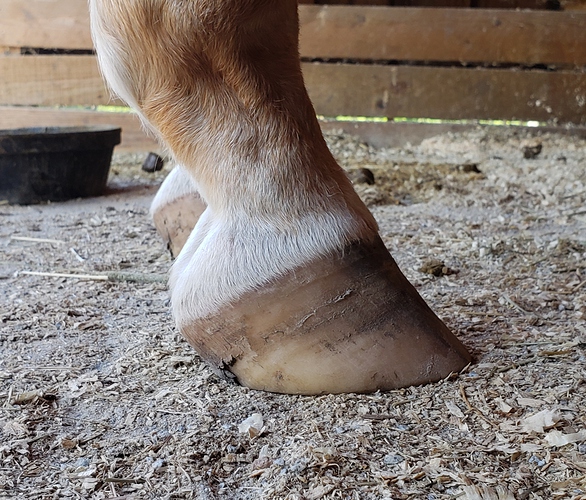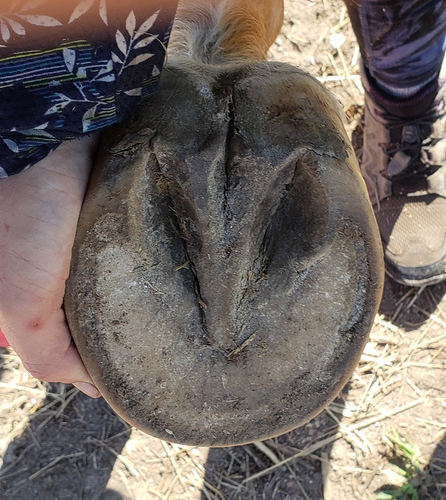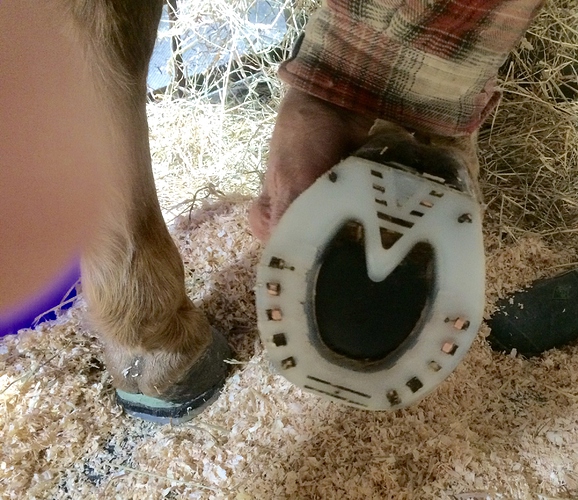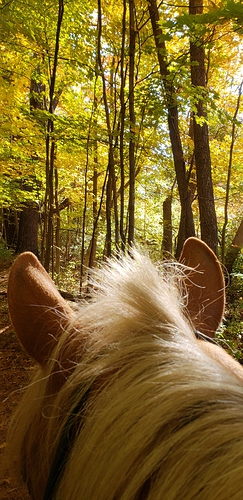My apologies, as I know I have posted about both of these things, but I’m not able to find those old threads. Go to the BOLD text for my questions if you want to skip the history…
Basics: mare was moved in July to a new barn. She is retired (last ride was in June) and is out 24/7, right now 22 hours on a dry lot with a shed, and 1 to 3 hours grazing, but the grass will go away at some point. Her food needs have increased since the move. Before, she had 6-7 hours of turnout and otherwise was in a stall. She is definitely moving around more now; her dry lot isn’t very big but she doesn’t stay in one spot. She is eating ~25 pounds of first cut mixed grass hay, 2 cups Buckeye Grow N Win balancer, 2 cups Outlast, 2 cups Renew Gold (the latter 3 split into 2 meals) – plus the 1 to 3 hours of grazing. One equioxx, 6000 IU natural vitamin E, 1/2 dose Quiessence, 10000 mg MSM. She is little – 14.3 and 925-950 pounds when in good weight. She dropped ~50 pounds after I moved her and is still gaining it back.
History of … too much. Arthritis, mild EPM, mild heaves, ulcers, possibly IR (but her insulin levels are currently normal, and she has lost weight). Suspensory desmitis in LH corrected with surgery in 2010 but she has a slightly short step on that leg. Pedal osteitis in both fronts, worse in the RF but not terrible. On and off lame in the RF, may have some DDFT damage (long story).
She is 24 but does not look or act it, though she has aged a lot in the past 18 months.
Hooves: her shoes got pulled in January, I used Keratex hoof hardener on them, and got her some Easycare Trail boots for trail riding and hand walking outside. She had one too-short trim in March and was in Easycare Clouds for 3 weeks. Fine (for her) after that… but we have had a very dry summer, and she’s outside all the time and hence stomping at flies more. Plus… my bad, after I moved her, the Keratex kind of went by the wayside. I am applying it 4 times a week now. One good thing: her hooves have expanded since pulling her shoes. She has gone up at least a full shoe size. At the new place I was, until last week, trail walking her 3 times a week, in her boots, for 30 to 45 minutes, which we both enjoy.
But now she’s lame on the RF again, and had hoof Xrays on Friday, which showed thin soles and long toes (new farrier doesn’t have her trim right yet, and I’m somewhat to blame for not warning him that she’s not easy to keep trimmed correctly.) She is temporarily out of boots because her hooves are bigger now so the old boots don’t fit. I bought some one size bigger and will try them on her in the morning.
Shoes: The thin soles have me thinking about putting her back in front shoes, but would like to avoid metal in favor of something a bit softer. Concussion from metal shoes cannot feel good with the amount of arthritis she has. I was thinking Eponas, but forget some other options. Note they MUST be something that can be studded or otherwise treated to improve traction in the winter. We are in New England and get a fair amount of snow and ice, and she will stay outside unless the weather is really, really bad. “Hard” composites like Polyflex do not work for her. Any ideas?
Hay: she is currently getting her hay in 1-inch net Hay Pillows, twice a day at roughly 7 a.m. and 6 p.m. I fear she may be going a long time without hay overnight, as any sort of slow feeder only slows her down so much. She has recently been really, really anxious about her food (to the point that it’s hard to lead her through grass even though she is usually well-mannered…). May have ulcers again, ugh.
The Hay Pillows are taking a beating outside in the stone dust, especially the zippers, and stuck zippers will be even worse to deal with in cold weather, so I am looking for another option – especially if she is in front shoes as she does paw at the hay pillows. Hanging hay nets on the wall of her shed does not work because she hurts her neck yanking on them.
Slow feed ideas: I would like something that can be set on the ground, and maybe have a small hole hay net attached inside, or some kind of small hole net cover (e.g. https://hayburnersequine.com/product/tub-topper-40/.) Options with larger holes, like Porta Grazers, do not slow her down enough.
Or (maybe, if BO is OK with it) what are peoples’ experiences with hanging a hay net in the center of a stall or shed so it just dangles and there is nothing to yank against?
Help?







